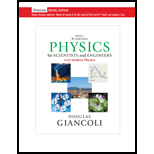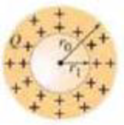
Physics for Scientists & Engineers, Volume 2 (Chapters 21-35)
5th Edition
ISBN: 9780134378046
Author: GIANCOLI, Douglas
Publisher: PEARSON
expand_more
expand_more
format_list_bulleted
Concept explainers
Textbook Question
Chapter 22, Problem 29P
(II) Suppose the nonconducting sphere of Example 22–4 has a spherical cavity of radius r1 centered at the sphere’s center (Fig. 22–32). Assuming the charge Q is distributed uniformly in the “shell” (between r = r1 and r = r0), determine the electric field as a function of r for (a) 0 < r < r1, (b) r1 < r < r0, and (c) r > r0.

Expert Solution & Answer
Trending nowThis is a popular solution!

Students have asked these similar questions
Please solve and answer this problem correctly please. Thank you!!
Please solve and answer this problem correctly please. Thank you!!
a) Use the node-voltage method to find v1, v2, and
v3 in the circuit in Fig. P4.14.
b) How much power does the 40 V voltage source
deliver to the circuit?
Figure P4.14
302
202
w
w
+
+
+
40 V
V1
80 Ω 02
ΣΑΩ
28 A
V3 +
w
w
102
202
Chapter 22 Solutions
Physics for Scientists & Engineers, Volume 2 (Chapters 21-35)
Ch. 22.1 - Which of the following would cause a change in the...Ch. 22.2 - A point charge Q is at the center of a spherical...Ch. 22.2 - Three 2.95 C charges are in a small box. What is...Ch. 22.3 - Prob. 1EECh. 22 - If the electric flux through a closed surface is...Ch. 22 - Is the electric field E in Gausss law....Ch. 22 - What can you say about the flux through a closed...Ch. 22 - The electric field E is zero at all points on a...Ch. 22 - Define gravitational flux in analogy to electric...Ch. 22 - Would Gausss law be helpful in determining the...
Ch. 22 - A spherical basketball (a nonconductor) is given a...Ch. 22 - In Example 226, it may seem that the electric...Ch. 22 - Suppose the line of charge in Example 226 extended...Ch. 22 - A point charge Q is surrounded by a spherical...Ch. 22 - A solid conductor carries a net positive charge Q....Ch. 22 - A point charge q is placed at the center of the...Ch. 22 - A small charged ball is inserted into a balloon....Ch. 22 - Prob. 1MCQCh. 22 - Prob. 2MCQCh. 22 - Prob. 3MCQCh. 22 - Prob. 4MCQCh. 22 - Prob. 5MCQCh. 22 - Prob. 6MCQCh. 22 - Prob. 7MCQCh. 22 - Prob. 8MCQCh. 22 - Prob. 9MCQCh. 22 - Prob. 10MCQCh. 22 - Prob. 1PCh. 22 - (I) The Earth possesses an electric field of...Ch. 22 - (II) A cube of side l is placed in a uniform field...Ch. 22 - (II) A uniform field E is parallel to the axis of...Ch. 22 - (I) The total electric flux from a cubical box...Ch. 22 - (I) Figure 2226 shows five closed surfaces that...Ch. 22 - (II) In Fig. 2227, two objects, O1 and O2, have...Ch. 22 - (II) A ring of charge with uniform charge density...Ch. 22 - (II) In a certain region of space, the electric...Ch. 22 - (II) A point charge Q is placed at the center of a...Ch. 22 - Prob. 11PCh. 22 - (I) Draw the electric field lines around a...Ch. 22 - Prob. 13PCh. 22 - (I) Starting from the result of Example 223, show...Ch. 22 - Prob. 15PCh. 22 - (I) A metal globe has l.50 mC of charge put on it...Ch. 22 - Prob. 17PCh. 22 - (II) A solid metal sphere of radius 3.00 m carries...Ch. 22 - (II) A 15.0-cm-diameter nonconducting sphere...Ch. 22 - (II) A flat square sheet of thin aluminum foil,...Ch. 22 - (II) A spherical cavity of radius 4.50 cm is at...Ch. 22 - Prob. 22PCh. 22 - Prob. 23PCh. 22 - (II) Two large, flat metal plates are separated by...Ch. 22 - (II) Suppose the two conducting plates in Problem...Ch. 22 - Prob. 26PCh. 22 - (II) Two thin concentric spherical shells of radii...Ch. 22 - (II) A spherical rubber balloon carries a total...Ch. 22 - (II) Suppose the nonconducting sphere of Example...Ch. 22 - (II) Suppose in Fig. 2232, Problem 29, there is...Ch. 22 - (II) Suppose the thick spherical shell of Problem...Ch. 22 - (II) Suppose that at the center of the cavity...Ch. 22 - (II) A long cylindrical shell of radius R0 and...Ch. 22 - (II) A very long solid nonconducting cylinder of...Ch. 22 - (II) A thin cylindrical shell of radius R1 is...Ch. 22 - (II) A thin cylindrical shell of radius R1 = 6.5...Ch. 22 - (II) (a) If an electron (m = 9.1 1031 kg) escaped...Ch. 22 - (II) A very long solid nonconducting cylinder of...Ch. 22 - (II) A nonconducting sphere of radius r0 is...Ch. 22 - (II) A very long solid nonconducting cylinder of...Ch. 22 - (II) A flat ring (inner radius R0, outer radius...Ch. 22 - (II) An uncharged solid conducting sphere of...Ch. 22 - (III) A very large (i.e., assume infinite) flat...Ch. 22 - (III) Suppose the density of charge between r1 and...Ch. 22 - (III) Suppose two thin flat plates measure 1.0 m ...Ch. 22 - (III) A flat slab of nonconducting material (Fig....Ch. 22 - (III) A flat slab of nonconducting material has...Ch. 22 - (III) An extremely long, solid nonconducting...Ch. 22 - (III) Charge is distributed within a solid sphere...Ch. 22 - Prob. 50GPCh. 22 - Prob. 51GPCh. 22 - The Earth is surrounded by an electric field,...Ch. 22 - Prob. 53GPCh. 22 - Prob. 54GPCh. 22 - Prob. 55GPCh. 22 - Prob. 57GPCh. 22 - Prob. 58GPCh. 22 - Prob. 59GPCh. 22 - Prob. 60GPCh. 22 - Prob. 61GPCh. 22 - Prob. 62GPCh. 22 - Prob. 63GPCh. 22 - Prob. 64GPCh. 22 - Prob. 65GPCh. 22 - Prob. 66GP
Additional Science Textbook Solutions
Find more solutions based on key concepts
1. How many significant figures does each of the following numbers have?
a. 0.73 b. 7.30 c. 73 d. 0.073
Physics for Scientists and Engineers: A Strategic Approach, Vol. 1 (Chs 1-21) (4th Edition)
What is the difference between cellular respiration and external respiration?
Human Physiology: An Integrated Approach (8th Edition)
Using the South Atlantic as an example, label the beginning of the normal polarity period C that began 2 millio...
Applications and Investigations in Earth Science (9th Edition)
Compare each of the mechanisms listed here with the mechanism for each of the two parts of the acid-catalyzed h...
Organic Chemistry (8th Edition)
1.14 Classify each of the following as a pure substance or a mixture. If a mixture, indicate whether it is homo...
Chemistry: The Central Science (14th Edition)
Suppose you are culturing a microorganism that produces enough lactic acid to kill itself in a few days. a. How...
Microbiology: An Introduction
Knowledge Booster
Learn more about
Need a deep-dive on the concept behind this application? Look no further. Learn more about this topic, physics and related others by exploring similar questions and additional content below.Similar questions
- Please solve and answer this problem correctly please. Thank you!!arrow_forwardYou're on an interplanetary mission, in an orbit around the Sun. Suppose you make a maneuver that brings your perihelion in closer to the Sun but leaves your aphelion unchanged. Then you must have Question 2 options: sped up at perihelion sped up at aphelion slowed down at perihelion slowed down at aphelionarrow_forwardThe force of the quadriceps (Fq) and force of the patellar tendon (Fp) is identical (i.e., 1000 N each). In the figure below angle in blue is Θ and the in green is half Θ (i.e., Θ/2). A) Calculate the patellar reaction force (i.e., R resultant vector is the sum of the horizontal component of the quadriceps and patellar tendon force) at the following joint angles: you need to provide a diagram showing the vector and its components for each part. a1) Θ = 160 degrees, a2) Θ = 90 degrees. NOTE: USE ONLY TRIGNOMETRIC FUNCTIONS (SIN/TAN/COS, NO LAW OF COSINES, NO COMPLICATED ALGEBRAIC EQUATIONS OR ANYTHING ELSE, ETC. Question A has 2 parts!arrow_forward
- The force of the quadriceps (Fq) and force of the patellar tendon (Fp) is identical (i.e., 1000 N each). In the figure below angle in blue is Θ and the in green is half Θ (i.e., Θ/2). A) Calculate the patellar reaction force (i.e., R resultant vector is the sum of the horizontal component of the quadriceps and patellar tendon force) at the following joint angles: you need to provide a diagram showing the vector and its components for each part. a1) Θ = 160 degrees, a2) Θ = 90 degrees. NOTE: USE DO NOT USE LAW OF COSINES, NO COMPLICATED ALGEBRAIC EQUATIONS OR ANYTHING ELSE, ETC. Question A has 2 parts!arrow_forwardNo chatgpt pls will upvotearrow_forwardThe force of the quadriceps (Fq) and force of the patellar tendon (Fp) is identical (i.e., 1000 N each). In the figure below angle in blue is Θ and the in green is half Θ (i.e., Θ/2). A) Calculate the patellar reaction force (i.e., R resultant vector is the sum of the horizontal component of the quadriceps and patellar tendon force) at the following joint angles: you need to provide a diagram showing the vector and its components for each part. a1) Θ = 160 degrees, a2) Θ = 90 degrees. NOTE: USE ONLY TRIGNOMETRIC FUNCTIONS (SIN/TAN/COS, NO LAW OF COSINES, NO COMPLICATED ALGEBRAIC EQUATIONS OR ANYTHING ELSE, ETC. Question A has 2 parts!arrow_forward
- ་ The position of a particle is described by r = (300e 0.5t) mm and 0 = (0.3t²) rad, where t is in seconds. Part A Determine the magnitude of the particle's velocity at the instant t = 1.5 s. Express your answer to three significant figures and include the appropriate units. v = Value Submit Request Answer Part B ? Units Determine the magnitude of the particle's acceleration at the instant t = 1.5 s. Express your answer to three significant figures and include the appropriate units. a = Value A ? Unitsarrow_forwardSolve and answer the question correctly please. Thank you!!arrow_forwardSolve and answer the question correctly please. Thank you!!arrow_forward
arrow_back_ios
SEE MORE QUESTIONS
arrow_forward_ios
Recommended textbooks for you

 Physics for Scientists and Engineers: Foundations...PhysicsISBN:9781133939146Author:Katz, Debora M.Publisher:Cengage Learning
Physics for Scientists and Engineers: Foundations...PhysicsISBN:9781133939146Author:Katz, Debora M.Publisher:Cengage Learning College PhysicsPhysicsISBN:9781285737027Author:Raymond A. Serway, Chris VuillePublisher:Cengage Learning
College PhysicsPhysicsISBN:9781285737027Author:Raymond A. Serway, Chris VuillePublisher:Cengage Learning Principles of Physics: A Calculus-Based TextPhysicsISBN:9781133104261Author:Raymond A. Serway, John W. JewettPublisher:Cengage Learning
Principles of Physics: A Calculus-Based TextPhysicsISBN:9781133104261Author:Raymond A. Serway, John W. JewettPublisher:Cengage Learning Physics for Scientists and Engineers with Modern ...PhysicsISBN:9781337553292Author:Raymond A. Serway, John W. JewettPublisher:Cengage Learning
Physics for Scientists and Engineers with Modern ...PhysicsISBN:9781337553292Author:Raymond A. Serway, John W. JewettPublisher:Cengage Learning Physics for Scientists and Engineers, Technology ...PhysicsISBN:9781305116399Author:Raymond A. Serway, John W. JewettPublisher:Cengage Learning
Physics for Scientists and Engineers, Technology ...PhysicsISBN:9781305116399Author:Raymond A. Serway, John W. JewettPublisher:Cengage Learning


Physics for Scientists and Engineers: Foundations...
Physics
ISBN:9781133939146
Author:Katz, Debora M.
Publisher:Cengage Learning

College Physics
Physics
ISBN:9781285737027
Author:Raymond A. Serway, Chris Vuille
Publisher:Cengage Learning

Principles of Physics: A Calculus-Based Text
Physics
ISBN:9781133104261
Author:Raymond A. Serway, John W. Jewett
Publisher:Cengage Learning

Physics for Scientists and Engineers with Modern ...
Physics
ISBN:9781337553292
Author:Raymond A. Serway, John W. Jewett
Publisher:Cengage Learning

Physics for Scientists and Engineers, Technology ...
Physics
ISBN:9781305116399
Author:Raymond A. Serway, John W. Jewett
Publisher:Cengage Learning
Electric Fields: Crash Course Physics #26; Author: CrashCourse;https://www.youtube.com/watch?v=mdulzEfQXDE;License: Standard YouTube License, CC-BY